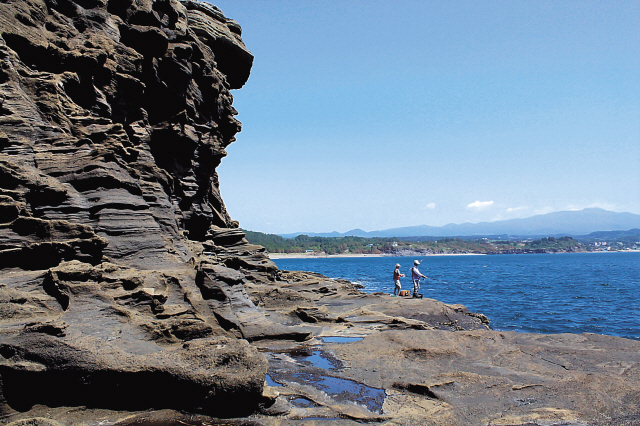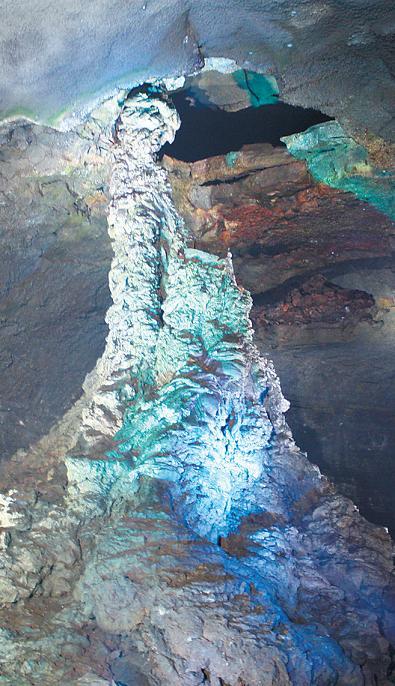Explore the geological marvels of ‘The island of the gods’
The one of a kind history and geography of Jeju Island
By Korea HeraldPublished : Nov. 16, 2012 - 20:15

JEJU ISLAND ― Whether it be the abundance of prehistoric volcanic remains, lava tubes or caves, Jeju Island is truly a geological wonder. The surreal scenery of the island will undoubtedly make for an unforgettable trip.
The island of Jeju itself is one giant extinct volcano, created by a massive eruption almost 2 million years ago. It is also home to 368 mountains and more than 160 lava tubes. The natural geology of Jeju Island is like none other in the world.
The island is the world’s first region to receive the UNESCO triple crown: Biosphere Reserve, World Heritage and Global Geoparks. Jeju was also declared one of the seven natural wonders of the world by the New7Wonders Foundation in 2011.
Cultural history
Jeju, sometimes referred to as “The island of the Gods,” was once an independent country named Tamna, meaning “island country.” Tamna was historically known as the kingdom of the sea, but was renamed Jeju, meaning “a big province across the sea,” during the Goryeo Kingdom.
Jeju is famous for having an abundance of three things: rocks, wind and women. The abundance of rocks and rubble originated from the volcanic activity of Hallasan, the mountain located smack in the center of the island and is the tallest mountain in South Korea.
Jeju is no stranger to the harsh forces of the sea. The abundance of heavy winds and storms often result in typhoons sweeping through the island. This ties in to the final abundance of women, which originated from the fact that many of the island’s men were lost at sea, resulting in a larger population of women.
Alongside the theme of the three abundances, Jeju is also known for the scarcity of three things: thieves, beggars and gates.
Historically, the people of Jeju always held high standards of morality and virtue. Due to the island’s small size and isolation, people relied heavily on one another, leading lives of interdependence rather than independence. Therefore, stealing and begging have never been a major issue on the island. And it was because of this trusting lifestyle that Jeju is also famed for not having fences or gates.
Geological wonders
One of the most unique aspects of Jeju is without a doubt its geology. The phrase, Jeju rocks come in all shapes and sizes, doesn’t even come close to describing the countless geological splendors and natural formations of the island.
One of the most iconic symbols of Jeju is the ancient rock statues known as dolharubang, or stone grandfather; “dol,” meaning rock, and “harubang,” meaning grandfather in the Jeju dialect. A dolharubang is a statue sculpted out of volcanic rock from the island. These statues are scattered all over the island and are generally designed with a somewhat human looking face, with large, circular bulging eyes; oversized broad, flat nose; long earlobes; and a mushroom cap shaped-like hat, which is often referred to as phallic. The hands are typically placed in front of the statue’s belly, with one hand placed above the other. The facial expressions vary from statue to statue and the size ranges from large, human-size sculptures to small desktop figurines.
Dolharubangs were considered to be gods offering both protection and fertility and were placed outside for protection. Superstition says that rubbing its nose will help make wishes come true. There is also a myth that rubbing its nose helps women conceive a son.
Some of the other major geological marvels of Jeju are the extensive lava tubes, known as oreum, prevalent throughout the region.
Located in the northeast corner of the island is the dark, damp oreum of Manjanggul. This cave is not only the largest lava tube on the island, but is one of the largest lava tubes in the world. Declared as a UNESCO World Heritage site, only approximately 1 km of the 13.4 km cave, which was formed around 2.5 million years ago, is open to the public in order to preserve its natural integrity. A lava tunnel is formed when the lava that was deeply penetrated into the ground erupts and flows out to the surface until the lava eventually cools and crusts.
The island of Jeju itself is one giant extinct volcano, created by a massive eruption almost 2 million years ago. It is also home to 368 mountains and more than 160 lava tubes. The natural geology of Jeju Island is like none other in the world.
The island is the world’s first region to receive the UNESCO triple crown: Biosphere Reserve, World Heritage and Global Geoparks. Jeju was also declared one of the seven natural wonders of the world by the New7Wonders Foundation in 2011.
Cultural history
Jeju, sometimes referred to as “The island of the Gods,” was once an independent country named Tamna, meaning “island country.” Tamna was historically known as the kingdom of the sea, but was renamed Jeju, meaning “a big province across the sea,” during the Goryeo Kingdom.
Jeju is famous for having an abundance of three things: rocks, wind and women. The abundance of rocks and rubble originated from the volcanic activity of Hallasan, the mountain located smack in the center of the island and is the tallest mountain in South Korea.
Jeju is no stranger to the harsh forces of the sea. The abundance of heavy winds and storms often result in typhoons sweeping through the island. This ties in to the final abundance of women, which originated from the fact that many of the island’s men were lost at sea, resulting in a larger population of women.
Alongside the theme of the three abundances, Jeju is also known for the scarcity of three things: thieves, beggars and gates.
Historically, the people of Jeju always held high standards of morality and virtue. Due to the island’s small size and isolation, people relied heavily on one another, leading lives of interdependence rather than independence. Therefore, stealing and begging have never been a major issue on the island. And it was because of this trusting lifestyle that Jeju is also famed for not having fences or gates.
Geological wonders
One of the most unique aspects of Jeju is without a doubt its geology. The phrase, Jeju rocks come in all shapes and sizes, doesn’t even come close to describing the countless geological splendors and natural formations of the island.
One of the most iconic symbols of Jeju is the ancient rock statues known as dolharubang, or stone grandfather; “dol,” meaning rock, and “harubang,” meaning grandfather in the Jeju dialect. A dolharubang is a statue sculpted out of volcanic rock from the island. These statues are scattered all over the island and are generally designed with a somewhat human looking face, with large, circular bulging eyes; oversized broad, flat nose; long earlobes; and a mushroom cap shaped-like hat, which is often referred to as phallic. The hands are typically placed in front of the statue’s belly, with one hand placed above the other. The facial expressions vary from statue to statue and the size ranges from large, human-size sculptures to small desktop figurines.
Dolharubangs were considered to be gods offering both protection and fertility and were placed outside for protection. Superstition says that rubbing its nose will help make wishes come true. There is also a myth that rubbing its nose helps women conceive a son.
Some of the other major geological marvels of Jeju are the extensive lava tubes, known as oreum, prevalent throughout the region.
Located in the northeast corner of the island is the dark, damp oreum of Manjanggul. This cave is not only the largest lava tube on the island, but is one of the largest lava tubes in the world. Declared as a UNESCO World Heritage site, only approximately 1 km of the 13.4 km cave, which was formed around 2.5 million years ago, is open to the public in order to preserve its natural integrity. A lava tunnel is formed when the lava that was deeply penetrated into the ground erupts and flows out to the surface until the lava eventually cools and crusts.

Once underground, dim lights illuminate the way of the nearly 1 km trek on the smooth lava rocks through the meandering tunnel of lava. At the end of the journey is the wondrous sight of a 7.6 m high lava column, the largest known lava column in the world.
Another breathtaking volcanic feature is the Sanbangsan lava dome, a bell-shaped mountain located in the far southwest corner of the island. Sanbangsan was formed as a result of violent volcanic activity almost 800,000 years ago and is in actuality a huge body of lava. The mountain also contains a cave with a Buddhist temple, located about 150m above sea level and has spectacular views overlooking the coast.
On the nearby coastline area of the giant lava dome is the surrounding tuff ring, known as "yongmeori," or dragon head, describing the shape of the giant rock formation that is one of the island’s oldest. Visitors can walk on and along Yongmeori, which stretches out into the sea from the base of Sanbangsan, allowing for some of the most picturesque views of the mountain and the velvety blue ocean.
Other must-sees
Jeju Island offers a long list of unforgettable sites, views and activities. Some of the other popular, must-see tourist attractions that display the miraculous natural phenomena of Jeju include: Seongsan Ilchulbong or sunrise peak and Hallasan National Park.
Seongsan Ilchulbong is one of the top tourist destinations of the island. Another of the island’s UNESCO World Heritage sites, the peak is a 90 m high crater that formed after a volcanic eruption more than 100,000 years ago.
Located at the heart and center of Jeju, Hallasan is the tallest mountain in Korea. The climb to the top of this mountain, which is actually an extinct volcano, will give one a spectacular view of a crater lake that is located at the peak. Hallasan National Park is open all year round and offers a wide-range of varied hiking trails and courses.
By Julie Jackson (juliejackson@heraldcorp.com)
-
Articles by Korea Herald






![[KH Explains] No more 'Michael' at Kakao Games](http://res.heraldm.com/phpwas/restmb_idxmake.php?idx=644&simg=/content/image/2024/04/28/20240428050183_0.jpg&u=20240428180321)



![[Grace Kao] Hybe vs. Ador: Inspiration, imitation and plagiarism](http://res.heraldm.com/phpwas/restmb_idxmake.php?idx=644&simg=/content/image/2024/04/28/20240428050220_0.jpg&u=)









![[Herald Interview] Xdinary Heroes shoot for the next level with 'Troubleshooting'](http://res.heraldm.com/phpwas/restmb_idxmake.php?idx=642&simg=/content/image/2024/04/29/20240429050745_0.jpg&u=)